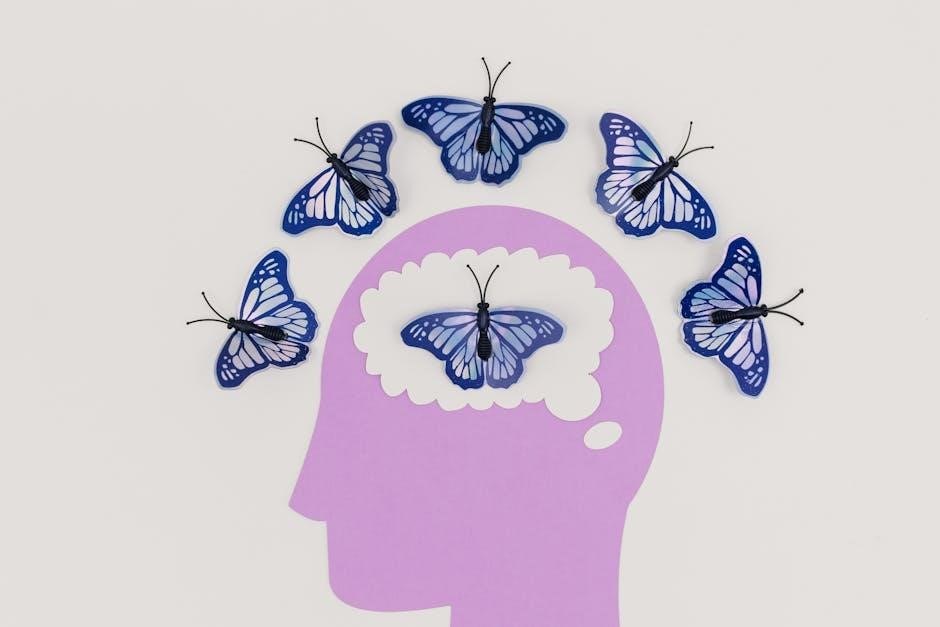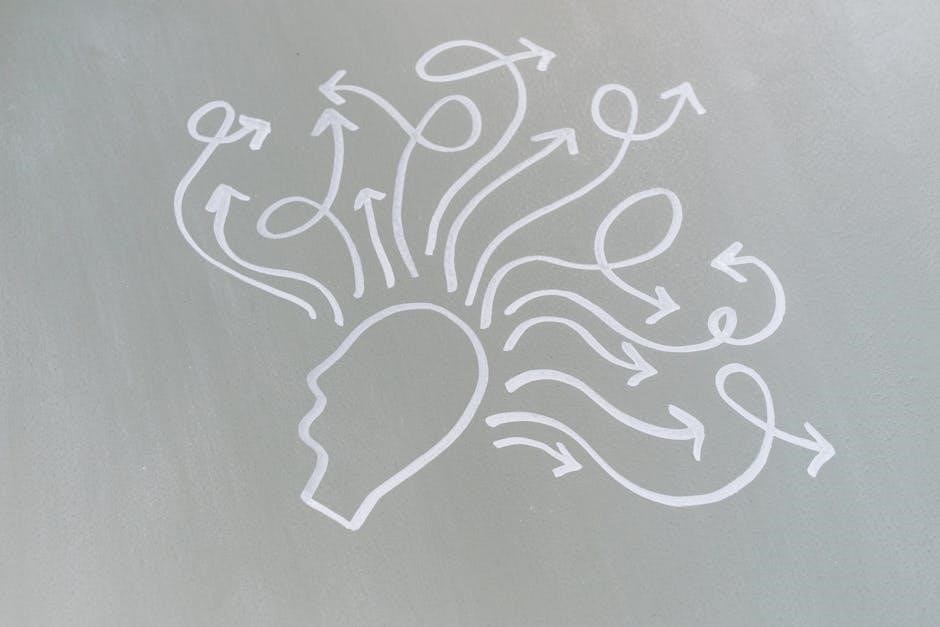The human brain is a complex and intricate organ, serving as the control center of the body. Its anatomy includes the cerebrum, cerebellum, and brain stem, each with unique functions. Understanding brain anatomy is essential for neuroscience, medicine, and psychology. Recent studies highlight the uniqueness of individual brain structures, emphasizing the importance of detailed anatomical knowledge.
1.1 Overview of Brain Structure
The human brain is divided into three primary structures: the cerebrum, cerebellum, and brain stem. The cerebrum, the largest part, is split into two hemispheres and controls higher cognitive functions, such as thought, memory, and voluntary movements. Beneath it lies the cerebellum, responsible for coordination, balance, and motor learning. The brain stem connects the cerebrum and cerebellum to the spinal cord, regulating vital functions like breathing, heart rate, and blood pressure. These structures are interconnected, forming a complex system that enables the brain to process information, control the body, and manage both conscious and unconscious activities. Understanding this structural organization is fundamental to grasping brain anatomy and its functional significance.
1.2 Importance of Brain Anatomy
Brain anatomy is crucial for understanding how the nervous system functions and controls the body. It provides the foundation for diagnosing neurological disorders, such as tumors, strokes, and injuries. Accurate anatomical knowledge aids surgeons, neurologists, and radiologists in developing precise treatments. Additionally, brain anatomy is essential for advancing neuroscience research, enabling insights into cognitive processes, memory, and behavior. Understanding individual variations in brain structure, as highlighted in studies, also helps tailor medical approaches to specific patient needs. This knowledge bridges the gap between clinical practice and research, offering a comprehensive view of the brain’s complexity and its role in human health and disease.

The Cerebrum
The cerebrum is the largest and most developed part of the brain, divided into two hemispheres. It controls higher functions like thought, memory, and voluntary movement.
2.1 Structure of the Cerebrum
The cerebrum is divided into two hemispheres, each consisting of four lobes: frontal, parietal, temporal, and occipital. These lobes are responsible for various functions. The frontal lobe handles executive functions, such as decision-making and motor control. The parietal lobe processes sensory information, while the temporal lobe is involved in memory and auditory processing. The occipital lobe primarily manages visual information. The cerebrum’s outer layer, the cerebral cortex, is composed of gray matter and contains billions of neurons that facilitate complex cognitive processes. Beneath the cortex lies white matter, which consists of myelinated axons that transmit signals between different brain regions. This intricate structure allows the cerebrum to coordinate and regulate a wide range of bodily functions and cognitive activities.
2.2 Functions of the Cerebrum
The cerebrum is the center of higher brain functions, including thought, emotion, memory, and voluntary movement. It processes sensory information, enabling perception of the environment. The frontal lobe is responsible for executive functions like decision-making, planning, and problem-solving, while the parietal lobe handles sensory input related to touch and spatial awareness. The temporal lobe plays a key role in auditory processing, language comprehension, and memory formation. The occipital lobe specializes in visual processing, interpreting signals from the eyes; The cerebrum also regulates motor functions, coordinating body movements and maintaining posture. Its ability to integrate these functions allows for complex behaviors, creativity, and consciousness, making it essential for human cognition and interaction with the world.
The Cerebellum
The cerebellum is located at the back of the brain and plays a crucial role in motor coordination, balance, and learning; Its folded surface enhances neural connectivity.
3.1 Structure of the Cerebellum
The cerebellum is a highly specialized structure located at the posterior fossa of the skull, below the cerebrum. It consists of two hemispheres connected by the vermis, a narrow band of tissue. The cerebellar cortex, its outer layer, is folded into numerous folia, increasing its surface area for neural processing. Beneath the cortex lies the white matter, known as the arbor vitae, which contains nerve fibers connecting the cerebellum to other brain regions. The cerebellum also contains deep nuclei, such as the dentate nucleus, which play a critical role in motor coordination. Its structure is divided into three lobes: anterior, posterior, and flocculonodular, each specialized for different motor functions.
3.2 Functions of the Cerebellum
The cerebellum is essential for motor coordination, balance, and posture. It regulates voluntary movements, ensuring precision and timing. It also plays a role in learning new motor skills, adapting movements based on experience. Beyond motor functions, the cerebellum contributes to emotional regulation and certain cognitive processes. Damage to this structure can lead to coordination issues, tremors, and balance problems. Its unique structure, with folded folia, allows for extensive neural connections, enabling complex processing. The cerebellum’s adaptability highlights its importance in both physical and mental tasks, making it a vital component of overall brain function.

The Brain Stem
The brain stem connects the cerebrum to the spinal cord, regulating vital functions such as breathing, heart rate, and blood pressure, essential for survival and bodily functions.
4.1 Structure of the Brain Stem
The brain stem is a compact yet vital structure connecting the cerebrum to the spinal cord. It is divided into three regions: the midbrain, pons, and medulla oblongata. The midbrain contains the tectum and tegmentum, while the pons consists of nuclei that relay signals between the cerebrum and cerebellum. The medulla oblongata connects to the spinal cord and regulates involuntary functions like heart rate and breathing. The brain stem also houses cranial nerve nuclei, which control sensory and motor functions of the face and head. Its compact structure belies its critical role in maintaining essential bodily functions and facilitating communication between the brain and body.
4.2 Functions of the Brain Stem
The brain stem performs crucial functions essential for survival. It regulates involuntary actions such as heart rate, breathing, and blood pressure, ensuring the body’s automatic processes operate smoothly. The brain stem also serves as a relay station for nerve signals between the cerebrum and the rest of the body, facilitating communication and coordination. It contains nuclei for cranial nerves, controlling sensory and motor functions of the face and head, including swallowing, hearing, and eye movements. Additionally, the brain stem plays a role in managing sleep-wake cycles and arousal levels, making it indispensable for maintaining consciousness and overall bodily functions. Its dysfunction can lead to severe neurological deficits, highlighting its importance in daily life and health.

Brain Anatomy in Medical Imaging
Medical imaging techniques like MRI and CT scans provide detailed visuals of brain structures, aiding in diagnosing abnormalities and understanding brain anatomy in clinical settings effectively.
5.1 MRI Scans of the Brain
Magnetic Resonance Imaging (MRI) provides detailed, high-resolution images of brain structures, enabling precise visualization of anatomy and pathology. MRI is non-invasive and uses magnetic fields and radio waves to generate images, making it ideal for diagnosing conditions like tumors, stroke, and neurological disorders. It excels in showing soft tissue differentiation, allowing clear identification of gray and white matter, as well as cerebrospinal fluid pathways. Advanced MRI techniques, such as functional MRI (fMRI), can even map brain activity. Clinicians rely on MRI for its ability to detect subtle anatomical variations and abnormalities, aiding in accurate diagnoses and treatment planning. Its role in brain anatomy studies is unparalleled, offering insights into both normal and pathological brain structures.
5.2 CT Scans of the Brain
Computed Tomography (CT) scans provide quick and detailed cross-sectional images of the brain, making them invaluable in emergency settings. Using X-rays and computer technology, CT scans identify structural abnormalities, such as fractures, hemorrhages, and tumors. They are particularly effective in detecting acute bleeding and skull injuries. Unlike MRI, CT scans are more accessible and faster, often used for initial assessments. While they offer less detail on soft tissues, advancements like high-resolution CT improve image clarity. CT scans are crucial for diagnosing conditions requiring immediate intervention, complementing MRI in comprehensive brain imaging. Their practicality and speed make them a cornerstone in clinical neuroimaging, especially for acute care and trauma cases.

Cerebral Circulation
Cerebral circulation involves a network of arteries and veins supplying blood to the brain, ensuring proper oxygenation and nutrient delivery. This system is vital for brain function.
6.1 Cerebral Arteries
The cerebral arteries form a complex network responsible for delivering oxygenated blood to the brain. The main cerebral arteries include the anterior, middle, and posterior cerebral arteries, which branch off from the circle of Willis. These arteries supply blood to specific brain regions, ensuring proper neuronal function. Damage to cerebral arteries, such as blockages or ruptures, can lead to severe conditions like strokes or aneurysms. Understanding their anatomy is crucial for diagnosing and treating cerebrovascular diseases. Advances in imaging techniques, such as MRI and CT scans, allow detailed visualization of cerebral arteries, aiding in early detection of abnormalities. Proper blood flow through these arteries is essential for maintaining cognitive function and overall brain health.
6.2 Veins and Venous System
The venous system of the brain plays a vital role in returning deoxygenated blood to the heart. Cerebral veins are divided into superficial and deep groups, with the superficial veins draining the outer layers of the brain and the deep veins handling the inner structures. These veins converge into larger sinuses, such as the superior and transverse sinuses, which empty into the jugular veins. Unlike arteries, veins lack thick walls and rely on surrounding tissues for support. Dysfunction in venous drainage can lead to conditions like cerebral venous sinus thrombosis, affecting brain function and health. Detailed imaging techniques help visualize the venous system, aiding in the diagnosis and treatment of related disorders. Maintaining proper venous circulation is essential for overall brain well-being and function.

Individual Variations in Brain Anatomy
Like fingerprints, no two brains are identical, with variations shaped by genetic and environmental factors. This uniqueness influences cognitive functions and personal traits, making each brain distinct.
7.1 Genetic Influences
Genetic factors significantly shape individual variations in brain anatomy, influencing the structure and function of regions like the hippocampus. Studies reveal that genetic differences contribute to unique brain organization, affecting cognitive abilities and emotional processing. For instance, variations in genes associated with neurodevelopment can lead to distinct cytoarchitectonic patterns in the brain. These genetic influences begin early in life, with hereditary traits determining the initial formation of brain structures. Research indicates that genetic makeup plays a crucial role in the size, connectivity, and functionality of brain regions, making each individual’s brain anatomy distinct. This genetic uniqueness, combined with environmental factors, results in the remarkable diversity observed in human brain structures and functions.
7.2 Environmental Factors
Environmental factors play a pivotal role in shaping individual variations in brain anatomy. Life experiences, lifestyle, and external influences significantly impact brain structure and function. For instance, education, stress levels, and nutritional intake can alter the development and connectivity of brain regions. Studies suggest that environmental factors, combined with genetic predispositions, contribute to the uniqueness of brain anatomy. Experiences during critical developmental periods can lead to structural changes, such as variations in hippocampal volume. Additionally, exposure to toxins or traumatic events can result in distinct anatomical features. These environmental influences underscore the dynamic interplay between nature and nurture in shaping brain anatomy, highlighting the importance of considering both genetic and external factors in understanding individual differences.
Neuroplasticity and Brain Adaptation
Neuroplasticity refers to the brain’s ability to reorganize itself by forming new neural connections. This adaptability is essential for learning and recovery, showcasing the brain’s remarkable capacity to reorganize and adapt throughout life.
8.1 Synaptic Plasticity
Synaptic plasticity is the brain’s ability to strengthen or weaken synapses, the connections between neurons. This process is fundamental to learning and memory, enabling neurons to communicate more effectively. Long-term potentiation (LTP) and long-term depression (LTD) are key mechanisms, enhancing or reducing synaptic efficiency. Such adaptations allow the brain to reorganize and refine its circuits, supporting cognitive functions and recovery from injury. Research shows synaptic plasticity is crucial for neural development and maintaining brain health throughout life.
8.2 Clinical Implications
Understanding synaptic plasticity has profound clinical implications, particularly in treating neurological and psychiatric disorders. Conditions like Alzheimer’s disease, stroke, and autism spectrum disorder often involve disruptions in synaptic communication. Neuroplasticity-based therapies aim to harness the brain’s adaptive potential to restore function. For instance, cognitive training and rehabilitation programs leverage synaptic plasticity to aid recovery in stroke patients. Additionally, insights into synaptic mechanisms inform drug development targeting specific pathways. Advanced imaging techniques, such as MRI, allow clinicians to map brain changes, guiding personalized treatments. These advancements highlight the critical role of synaptic plasticity in improving patient outcomes and developing innovative therapies for brain-related disorders.

Functional Organization of the Brain
The brain’s functional organization involves specialized regions coordinating to enable complex functions. The cerebrum manages cognition, emotions, and voluntary movements, while the cerebellum oversees motor coordination and balance.
9.1 Lobes of the Brain
The human brain is divided into four distinct lobes: frontal, parietal, temporal, and occipital. Each lobe specializes in specific functions. The frontal lobe manages executive functions like decision-making, problem-solving, and motor control. The parietal lobe processes sensory information, such as touch and spatial awareness. The temporal lobe is crucial for hearing, memory, and language processing. The occipital lobe primarily handles vision. Together, these lobes form a coordinated system enabling complex cognitive and motor functions. Understanding their roles is essential for neurology and psychology. The cerebellum, while not a lobe, supports motor coordination and balance, complementing the cerebrum’s functions. This functional organization underscores the brain’s remarkable adaptability and efficiency.
9.2 Cerebral Cortex
The cerebral cortex is the outer layer of the cerebrum, responsible for processing sensory information, controlling movement, and facilitating thought, memory, and language; It is divided into six distinct layers of neurons, each with specific functions. The cortex is organized into functional areas, such as Brodmann areas, which specialize in tasks like motor control and sensory processing. Its structure and organization enable complex cognitive functions, making it a cornerstone of human intelligence and adaptability. The cortex’s intricate folding increases its surface area, allowing for a high density of neurons and synaptic connections. This remarkable organization underpins the brain’s ability to process information and adapt to changing environments, highlighting its critical role in human cognition and behavior.

Detailed Anatomy of the Brain Stem and Cerebellum
The brain stem connects the cerebrum to the spinal cord, comprising midbrain, pons, and medulla, regulating vital functions. The cerebellum, behind the brain stem, coordinates motor activities and balance, ensuring precise movements and posture control, while also contributing to learning and memory processes.
10.1 Brain Stem Regions
The brain stem is divided into three distinct regions: the midbrain, pons, and medulla oblongata. The midbrain acts as a relay station for auditory and visual information, while also regulating body temperature and alertness. The pons contains nuclei that transmit signals between the cerebrum and cerebellum, playing a key role in sleep and sensation. The medulla oblongata, the lowest part of the brain stem, controls vital functions such as breathing, heart rate, and blood pressure. These regions are interconnected, ensuring seamless communication between the brain and the rest of the body. Damage to any part can lead to severe neurological deficits, highlighting the brain stem’s critical role in maintaining life and bodily functions.
10.2 Cerebellar Structures
The cerebellum consists of the cerebellar cortex and underlying white matter, with distinct structural features. The cerebellar cortex is organized into layers of neurons, including Purkinje cells, which are vital for motor coordination. The cerebellum is divided into lobes and fissures, such as the primary fissure, separating the anterior and posterior lobes. The cerebellar nuclei, located deep within the cerebellum, process and relay information to other brain regions. These structures work together to regulate motor control, balance, and learning. Recent studies also suggest individual variations in cerebellar anatomy, influenced by genetic and environmental factors, which may relate to functional differences in motor skills and cognitive abilities across individuals.

White and Gray Matter
White matter consists of myelinated nerve fibers, enabling rapid communication between brain regions. Gray matter contains neuron cell bodies, crucial for information processing, motor control, and higher cognitive functions.
11.1 Composition of White Matter
White matter is primarily composed of myelinated nerve fibers, which are axons covered by a myelin sheath. This myelin, produced by oligodendrocytes, enhances the speed of neural impulses, facilitating efficient communication between different brain regions. The myelin sheath acts as an insulator, reducing signal loss and ensuring precise transmission. White matter also contains glial cells, such as astrocytes, which provide structural and metabolic support. The organization of white matter tracts is crucial for maintaining the brain’s functional connectivity. Damage to white matter, as seen in conditions like multiple sclerosis, can disrupt neural communication, leading to various cognitive and motor impairments. Understanding its composition is vital for diagnosing and treating neurological disorders.
11.2 Functions of Gray Matter
Gray matter is composed of neuron cell bodies and is essential for processing information within the brain. It plays a critical role in controlling voluntary movements, sensory perception, memory, emotion, and cognitive functions. The cerebral cortex, a layer of gray matter, is responsible for higher-order thinking, decision-making, and language processing. Gray matter also facilitates communication between different brain regions by integrating sensory and motor information. Damage to gray matter, such as in conditions like Alzheimer’s disease, can lead to significant cognitive and functional impairments. Understanding its functions is crucial for diagnosing and managing neurological and psychiatric disorders. The unique organization of gray matter contributes to individual differences in brain function and behavior. Its study remains a focal point in neuroscience and neurology.

Clinical Applications and Technological Advancements
Advancements in brain imaging, such as MRI and CT scans, have revolutionized diagnostic techniques and treatment planning in neurology and neurosurgery, enhancing precision and patient outcomes significantly.
12.1 Diagnostic Techniques
Modern diagnostic techniques, such as MRI and CT scans, provide detailed insights into brain anatomy, enabling precise identification of structural abnormalities. MRI scans are particularly effective for visualizing soft tissue, making them ideal for detecting conditions like tumors, stroke damage, or multiple sclerosis. CT scans, while less detailed, are often used in emergencies to quickly assess injuries or bleeds. These imaging methods are complemented by functional MRI (fMRI) and diffusion tensor imaging (DTI), which map brain activity and connectivity. Advanced software enhances image clarity, aiding in early diagnosis and treatment planning. These tools are indispensable in neurology and neurosurgery, improving patient outcomes by enabling targeted interventions.
12.2 Brain Mapping Technologies
Brain mapping technologies have revolutionized the study of brain anatomy and function. Functional MRI (fMRI) and diffusion tensor imaging (DTI) are key tools for mapping brain activity and connectivity. These technologies allow researchers to visualize how different brain regions communicate and function in real-time. High-resolution MRI scans provide detailed anatomical maps, while Brain Mapping Technologies like magnetoencephalography (MEG) and electroencephalography (EEG) capture dynamic neural activity. These advancements enable precise localization of brain functions, aiding in neuroscience research and clinical applications. Brodmann areas, identified through histological studies, are now integrated with modern imaging to map cortical regions. Such technologies enhance understanding of brain organization and its variability, fostering advancements in neurology and personalized medicine. They are invaluable for studying both healthy and diseased brains, offering insights into cognition, behavior, and neurological disorders.